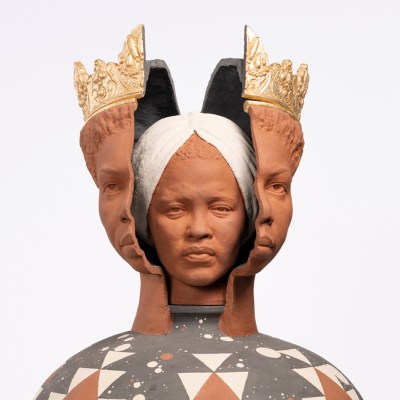
On 10 October, Arjun Sajip, digital editor of Apollo, was in conversation with the British artist Rayvenn Shaleigha D’Clark at TM Gallery to mark the opening of her exhibition ‘Digital Flesh: The Texture of Identity’.
D’Clark is best known for exploring themes of representation, remembrance, beauty and Black identity through sculptures that are lifecast using 3D scanning and modelling technology, resulting in exact renderings of real people. She has made several public sculptures, including three that are permanently displayed at the Freedom Monument Sculpture Park in Montgomery, Alabama, which opened earlier this year.
First inspired to become an artist in her A-level years by seeing the work of Kara Walker, D’Clark began her career as an MA student at the Chelsea College of Art and Design. Over the course of the conversation, which was organised in collaboration with MTArt Agency, she talked the audience through the lifecasting on which she has built her name: once she finds a willing model, she 3D-scans them and combines numerous scans from different angles to stitch together a virtual model that can be printed in various materials. But the software, like so much visual technology from years gone by, does not cope well with darker skin tones. ‘A lot of the time, I’m battling this technology I’m really in love with to make as detailed renders of [the models as possible],’ she said. ‘I’m trying to capture that thing about [the subject] that I feel, and the dynamic of my relationship with them.’
She was very open about how collaborative her practice is, with a team of technicians helping translate her visions to reality. ‘I love working like that,’ she said. ‘It’s really good to lean on people who know and understand the process […] When we were doing our project in the United States, the CAD guy had been using the tech I’m now using for 20 years, but we were both learning at the same time. When we were thinking about how to simulate Afro hair, there were certain visuals I wanted that the CAD guy had never considered. He understood it from a very practical standpoint, while I was very emotively trying to get it to look a certain way.’
D’Clark had much to say about the political impetus behind her work, which she sees as a reaction against certain curatorial tendencies in museums and galleries concerning the way Black bodies are presented. But the politics of her work are subtle, characterised by what she calls ‘normalcy’: ‘Sometimes you encounter images of Black figures and there seems to be this aura around it – it sits within a realm that doesn’t seem to be normal or everyday. It seems that when a lot of institutions put out Black art, it’s like, “Look at what we’re doing.” But as a Black person born in the UK, my presence as a Black person is so normal to me and so many others that I don’t want my art to have some kind of “hero” rhetoric around it.’
Anyone curious about D’Clark’s practice can see a selection of her works at ‘Digital Flesh: The Texture of Identity’, which is at TM Gallery until 21 November.


